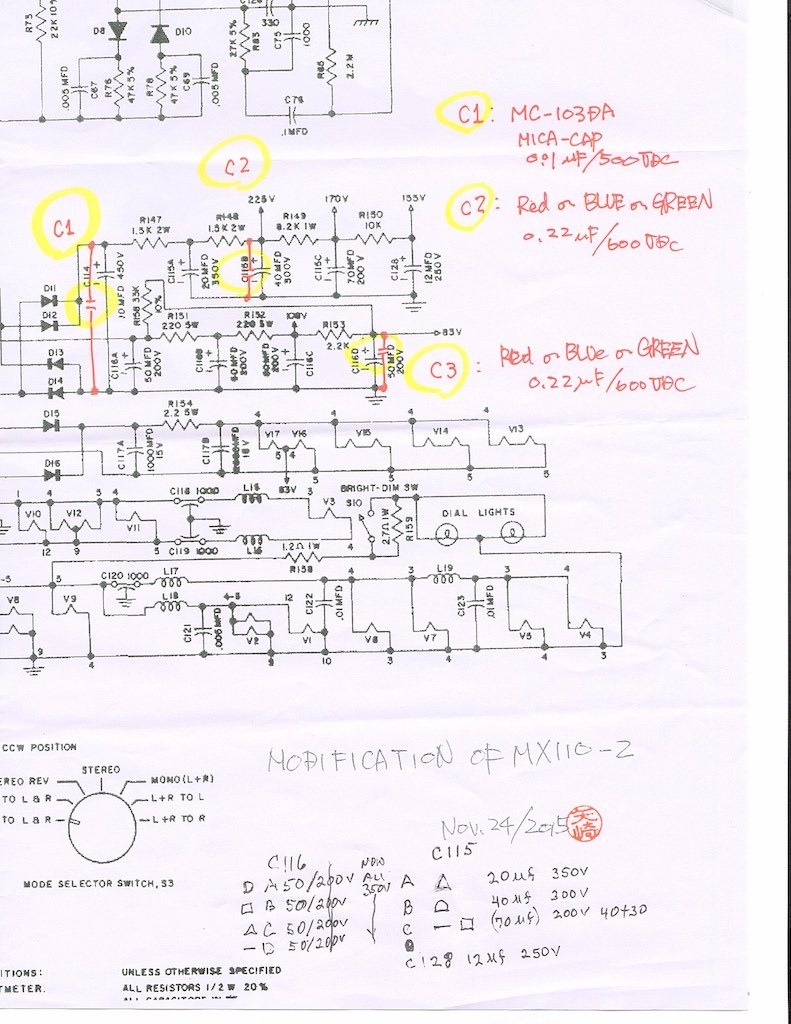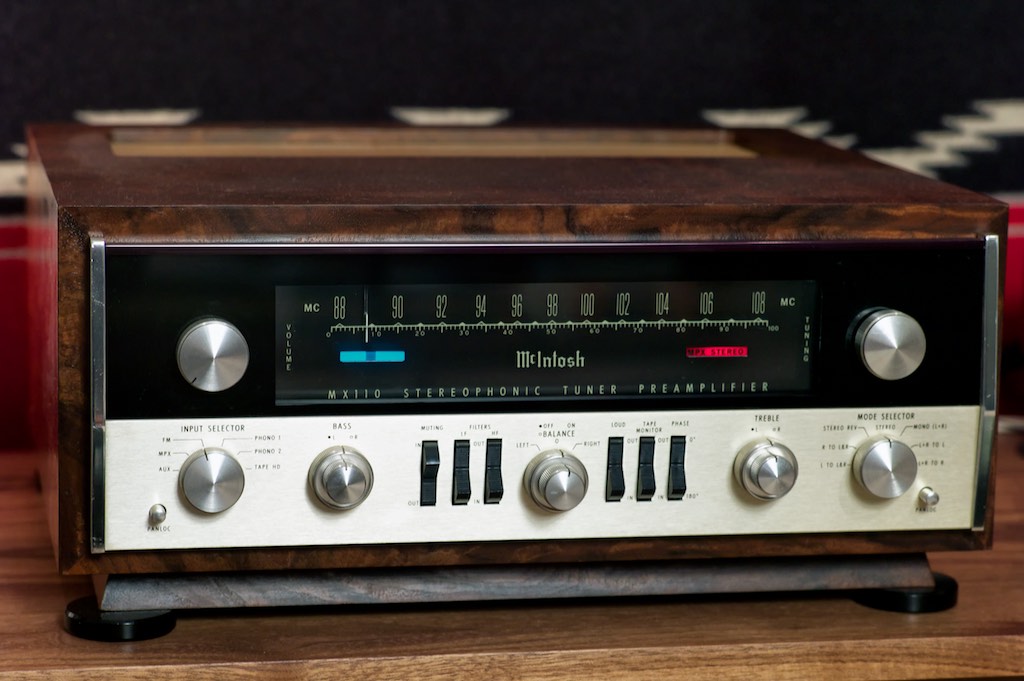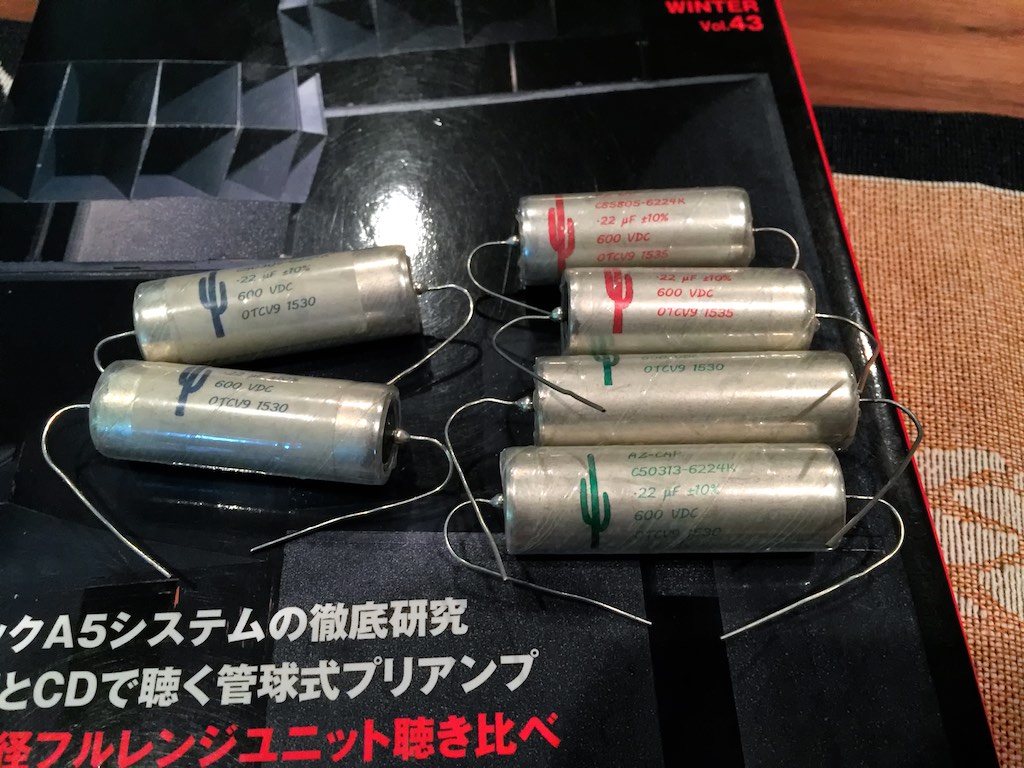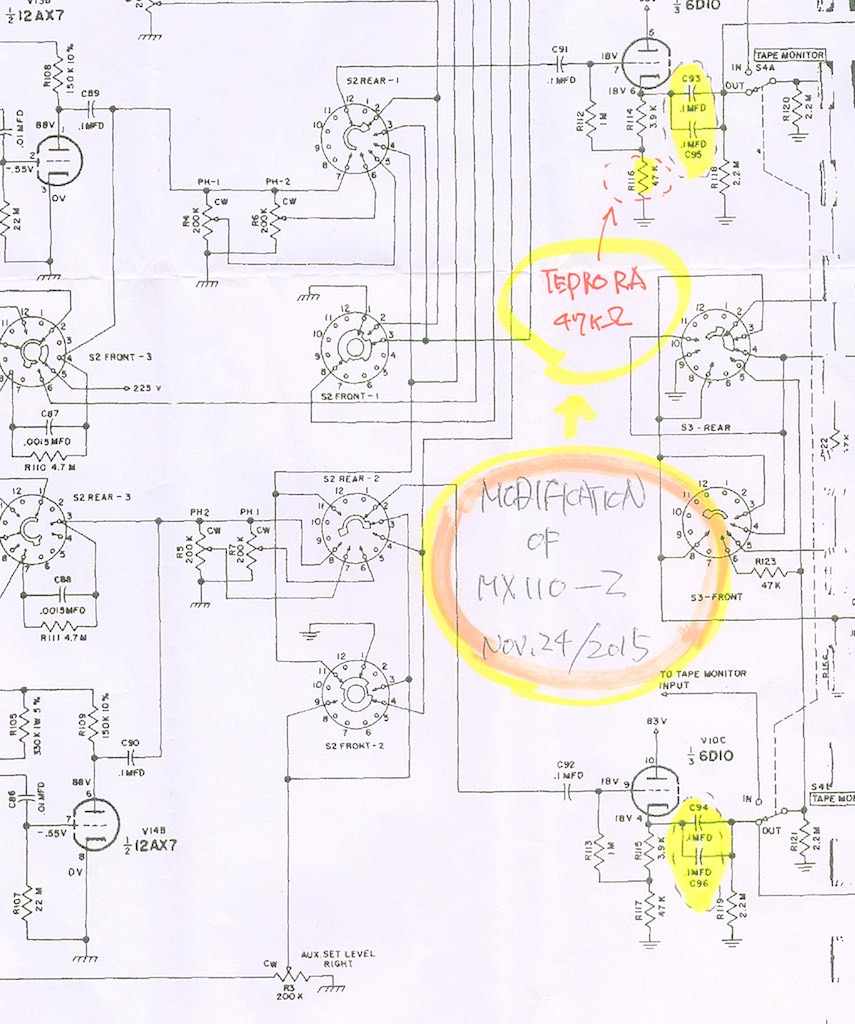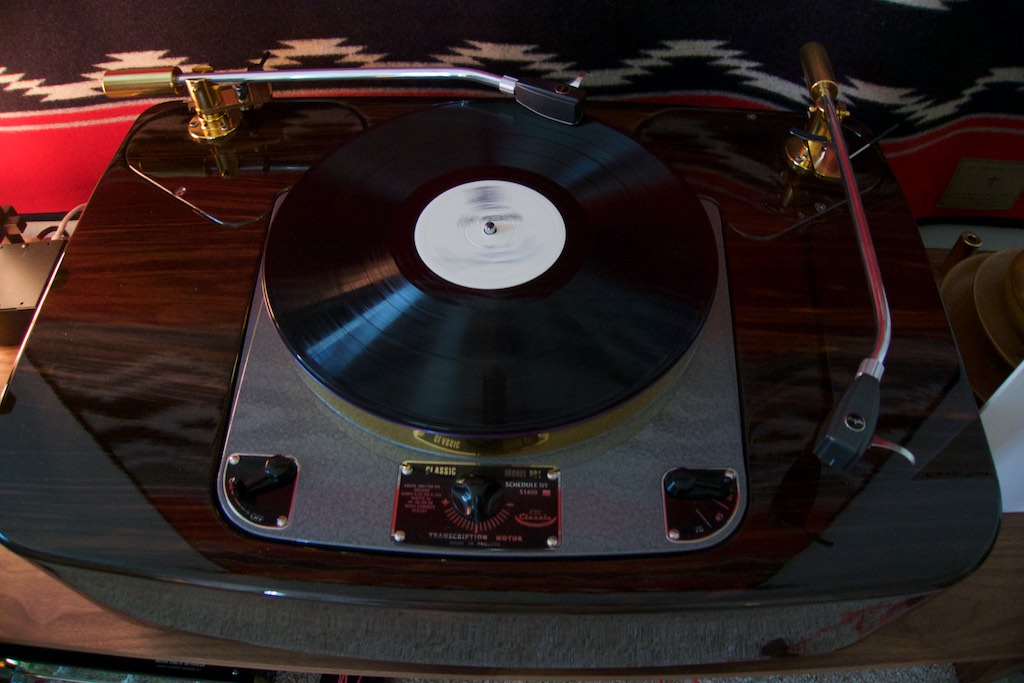A good alternate title for this post would have been "The Real Sound Education of Jeff Day" because that is the result of Yazaki-san's and Ron-san's influence on me during our mutual adventures with the vintage McIntosh vacuum tube gear.
Due to Ron's influence, I have now made the transition of being a modification observer to becoming brave enough to pick up my soldering iron and modifying circuits in the MX110s, as long as it's a simple sort of thing like soldering in & out capacitors and resistors.
It is an illuminating & empowering experience, and something I would never have imagined myself doing to an MX110 even a few scant months ago!
It comes as a complete surprise to me that changing one capacitor or resistor in the circuit of the MX110s makes as much difference as I hear when swapping between entire components like preamplifiers or amplifiers in my hi-fi systems.
The implications of this for me are enormous, as I have been long dependent upon swapping components at the macro level (sources, amplifiers, preamplifiers, loudspeakers, cables, etc.) to dial in my musical enjoyment with my hi-fi, but now I can delve into the electronic genome of my existing equipment and dial in the sound exactly the way I want it at the micro level without having to buy a new piece of gear - that's powerful and wonderful!
Yazaki-san's influence on me has been to teach me how to be adventuresome and how to think about achieving Real Sound in my system and components through the addition of a few judicious modifications to nudge things in the right direction.
If you're new toYazaki-san or Jeff's Place, I should probably describe to you what the essence of Real Sound is before I go any further so you know what the context is of what we're talking about.
When Yazaki-san introduced his concept of Real Sound to me, he described it to me as reproducing a “tone that is beautiful, rich, and penetrating, as if appealing directly to the human emotions, a real three dimensional field, and a musical sound full of dynamism! Accordingly, we could find more clearly the unique fine technique of player and be moved by feeling the soul of virtuoso directly.”
I feel very fortunate that Yazaki-san, Ron-san, and I are very much kindred spirits in what we think is important in sonic & musical terms, which gives us a wonderful artist's palette of techniques & components to work from based on Yazaki-san's knowledge & experience in our quest for Real Sound.
I am in awe of Yazaki-san's experience & talents in building equipment from scratch, like he did with his own personal DA30 SET amplifier, and his SPEC (and other previous) designs, and also for his ability to provide recommendations to move my existing vintage McIntosh components towards my personal interpretation of Real Sound through insightful modifications to their circuitry.
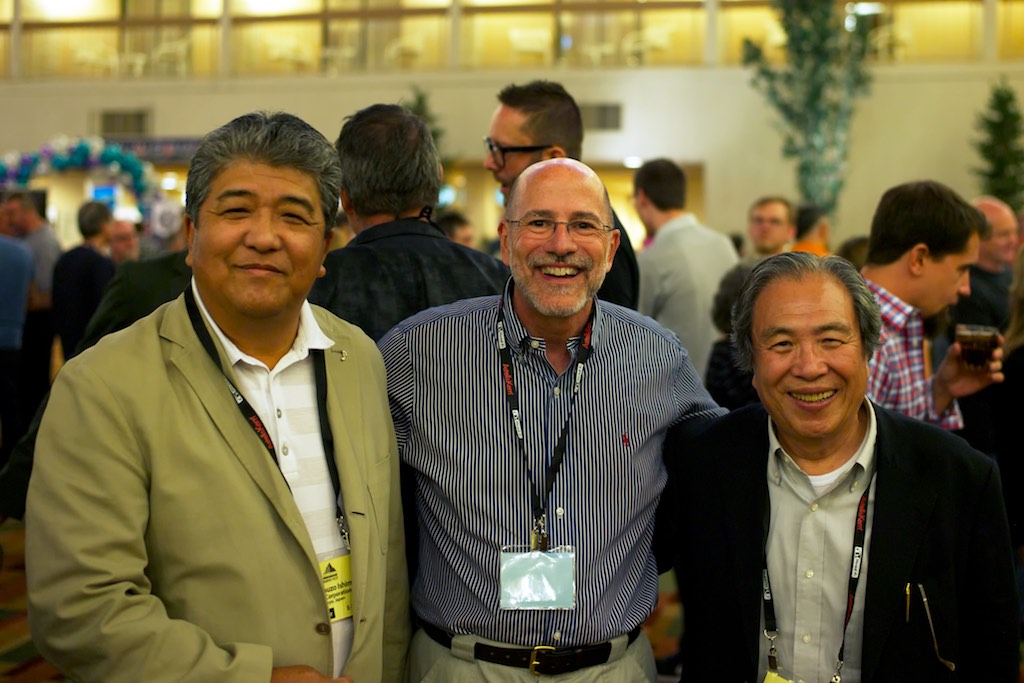
Ishimi-san, Jeff, and Yazaki-san (L to R) at RMAF 2015. It was a true pleasure to meet these gentleman at RMAF!
I have been meditating on all these things I have been learning from Yazaki-san & Ron-san and have come up with a sort of mental framework for how to think about realizing Real Sound in my own components and hi-fi systems.
I now consider a given component as a starting point (like the MX110), with its own unique musical & sonic balance in the context of my larger hi-fi system, and then I think about how I might apply a palette of different circuit modifications & components (capacitors, resistors, etc.) to move it towards my personal vision of musicality & sonics for my hi-fi to achieve Real Sound.
As I have learned from Yazaki-san, applying the principles of improving & voicing a component in Real Sound fashion is a combination of science & knowledge, of art & inspiration, along with a willingness to experiment, and with a large portion of patience as one works through the various permutations to realize one's personal goal for Real Sound.
The knowledge & science part of achieving Real Sound comes into play via Yazaki-san's immense knowledge & experience in how circuits function, a vast knowledge of the sonic & musical traits of a wide range of individual capacitors, resistors, etc., that make up a circuit, and how each of those might be applied to a given circuit at key positions to achieve Real Sound.
This combination of knowledge and skill is what makes it possible for Yazaki-san to look at a circuit like that of the MX110 and make suggestions for improving it in key circuit locations in Real Sound fashion, as in the diagram above for the MX110's power supply.
Modification A, the phono input resistors:
In my last post I described the evolution of our resistor adventure with the MX110 in Modification A. In Modification A we experimented with the input resistors at R88 & R90 (left inputs) and R89 & R91 (right inputs) for PH-1 & PH-2, respectively. These phono stage input resistors have a major influence on the sound quality of the phono stage of the MX110 because they are in the first position at which the MX110 sees the music signal coming in from the turntable.
Along the way in our resistor adventure we had also experimented with substituting various resistors at R116/R117 and R94 & R95, but eventually we came to the conclusion that there was a reason that McIntosh chose Allen Bradley carbon comp resistors as the OEM resistors for those locations, as they sounded the most natural & musical. So we went back to NOS 2-watt Allen Bradley's in all those locations.
What I learned about the voicing of the vintage McIntosh MX110 tuner-preamplifier during our resistor adventure is that the good folks of McIntosh did a wonderful job of voicing the MX110, and it is balanced on a knife edge between neutrality & musicality. If you choose resistors that are cooler, less rich, or more tonally lean than the Allen Bradley carbon comps, then you will be rewarded with sound that is too lean, edgy, and forward in the presence region of the human voice (2048 to 8192 Hz), and the MX110's overall tonality & musicality will collapse.
My preferred input resistor choices ended up being the NOS Allen Bradley carbon comp 2-watt resistors at PH-2 for R89 & R91, and the 56KΩ Tepro RA 1/2-watt resistors on PH-1 for R88 & R90.
This gives me the ability to do some longer term listening comparisons to the renowned classic NOS Allen Bradley carbon comp resistors vs. the Tepro RA metal film resistors to see how my initial impressions hold up over time.
In this post my main goal is to describe to you the results of my recent capacitor adventure with the 0.22uF Red, Blue, and Green Cactus Arizona Capacitors in Modifications B (1st stage cathode follower of the high-level input) and C (power supply).
What I learned about the voicing of the vintage McIntosh MX110 tuner-preamplifier during our resistor adventure also applies equally to our capacitor adventure in Modifications B & C. If you choose capacitors that are cooler, less rich, or more tonally lean than the OEM capacitors in the MX110, then you will be rewarded with sound that is too lean, edgy, and forward in the presence region of the human voice (2048 to 8192 Hz), and the MX110's overall tonality & musicality will collapse.
My conclusion is that it is quite difficult to improve on the sonics & musicality of the stock MX110, but it is possible.
Modification C, the power supply:
Let me first tell you about my discoveries related to Modification C (the power supply) before before I tell you what I've found out about Modification B (the first stage cathode follower of the high-level input), because it is important preliminary information to understanding what is happening in Modification B.
If you look at Yazaki-san's diagram above for Modification C you can see three additions to the power supply of the MX110, the first is a SPEC Ruby-Mica bypass capacitor (MC103DA, 0.01μF / 500VDC) added to the circuit at C1, and the second & third a 0.22uF Red, Green, or Blue Cactus Arizona Capacitor added at C2 & C3.
I asked Yazaki-san if he could explain for me why he suggested those changes for the MX110's power supply, to see I could get a better understanding of what the modifications were doing, and what sort of changes they wrought upon the sonics & musicality of the MX110. Here's what he told me:
"C1 is used as the noise cut filter of the bridge diodes at D11, D12, D13, D14. I had intended to change these diodes to our ST microelectronics STTH6110TV2 ultra-fast soft recovery type because the switching noise level of the diode is so important a factor for the sound. But the space in the MX110 looked so limited that I came up with an idea of how to reduce the noise of D11~D14 at C1 with the Mica-Ruby capacitor. The Mica-Ruby capacitor's high-frequency characteristics are so splendid that the switching noise of these diodes could flow into the ground through C1.
C2 and C3, connected in parallel, are used for strengthening the electrolytic capacitor as decoupling / bypass capacitors. These decoupling capacitors are used as the local power supply of each plate voltage. C2 could cover V13 A/B, V14 A/B, V15 A/B, V16 A/B, and V17 A/B. C3 covers V10 B/C.
In general, the electrolytic capacitor's characteristic, such as ESR for high frequency over 10kHz, is poor, so that when you add AZ cap connected in parallel, you could easily improve the ESR of mid-to-high frequency range of the bypass capacitor, and the sound could be faster and more clear than ever."
When we started this adventure, Yazaki-san had sent us two pairs each of 0.22uF Red, Green, and Blue Cactus Arizona Capacitors to experiment with. One pair each went into Modification B to the first stage cathode follower of the high-level input, with Leo's MX110 getting a pair of Green Cactus, George's a pair of Blue Cactus, and mine a pair of Red Cactus.
Then we mixed the alternate colors in each of the MX110 power supplies for Modification C, which we thought might balance things out sonically & musically with Modification B by blending the voices of the three tone colors of the Arizona Capacitors. So Leo's MX110 with the Green Cactus at Mod B got a combination of Red & Blue Cactus at C2 & C3, George's with the Blue Cactus at Mod B got a combination of Red & Green Cactus at C2 & C3, and mine with a pair of Red Cactus for Mod B got a Green & Blue Cactus at C2 & C3.
In this capacitor blending experiment Ron, Leo, and I, came to the conclusion that Leo's MX110 sounded the best (Green Cactus at Mod B, and Red & Blue Cactus at C2 & C3), George's MX110 sounded the worst (Blue Cactus at Mod B, and Red & Green Cactus at C2 & C3), and my MX110 was somewhere in between (Red Cacti for Mod B, and Green & Blue Cacti at C2 & C3).
I have found through trial & error by substituting Red, Green, and Blue Arizona Capacitors into the power supplies that the addition / subtraction of a single Red, Blue, or Green Cactus capacitor had an enormous influence on the overall sonics & musicality of the MX110. The influence is so large that it is a make-it or break-it sort of deal. If you pick the wrong combination of caps the MX110 sounds like crap, which of course I did 2 out of 3 times when blending different capacitor combinations for Modification C!
That's the sort of situation where the desire to experiment and a big dose of patience becomes your friend in these adventures.
Like Frodo, Sam, Merry, and Pippin in their adventures in The Lord of the Rings, we encountered our fair share of unexpected twists and turns along the way with our MX110 adventure, but it has been such a rewarding learning experience I wouldn't trade it for anything, so it's all good!

Here's my MX110 with a Green Cactus in the power supply. It made the sound too forward in combination with the Red Cacti in Mod B (far right).
If you'll note that in our original Modification C that Red & Blue Cacti capacitors in C2 & C3 sounded the best, and both George's and my MX110s with a Green Cactus capacitor in the power supply did not sound so good.
It turns out that the MX110 does not like to have a Green Cactus Arizona Capacitor added to its power supply. A Green Cactus capacitor added to the power supply gives an astonishing sense of immediacy, space, and presence to images which was quite intoxicating, but it also allowed a harshness & edginess on female vocals & muted trumpets in the presence region to come through that was intolerable.
I find this result with the Green Cactus quite interesting and perplexing, as it sounds completely different (and very good) when used in Modification B for the first stage cathode follower of the high-level input. For some reason, a Green Cactus capacitor just doesn't work well in the MX110's power supply (George's or my MX110s), and sounds completely the opposite of the very good result a pair of Green Cacti capacitors provide in Modification B.
So far, the best blending of Arizona Capacitors in the MX110 power supply I have come upon is the combination of Red & Blue Cactus at C2 & C3, and it is that combination that I chose as the baseline from which to evaluate Modification C.
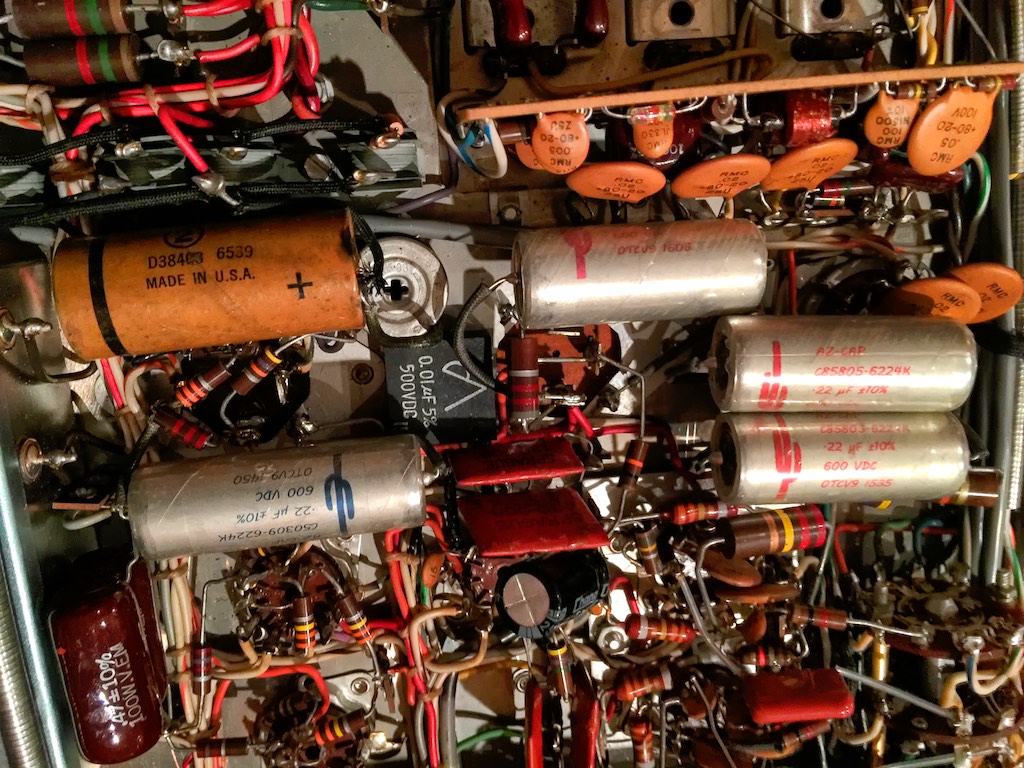
From the left: Blue Cactus at C3, SPEC Ruby-Mica cap at C1, Red Cactus at C2 (all for the power supply), and 2 Red Cacti for Mod B in the first stage cathode follower of the high-level input.
The configuration of coupling caps in the power supply has such a large influence on the overall sound that I'd like to explore a few other permutations, but I haven't yet. I think the trying a pair of Blue Cacti in both C2 & C3 could be very interesting, but that is an experiment for another day as I don't have enough Blue Cacti on hand to try it. Maybe as a follow up.
Now that I have normalized the baseline of Leo's, George's, and my MX110s with the good sounding combination of (1) a SPEC Ruby-Mica bypass capacitor (MC103DA, 0.01μF / 500VDC) added to the circuit at C1, (2) a 0.22uF Red Cactus Arizona Capacitor added to the circuit at C2, and (3) a 0.22uF Blue Cactus Arizona Capacitor added to the circuit at C3 I can say something meaningful about the overall sonic & musical traits of the Red, Green, and Blue Cactus Arizona Capacitors as used in Modification B.
Modification B, the first stage cathode follower of the high-level input:
With the same configuration of coupling capacitors at C1, C2, and C3, in the power supply of all three MX110s, I was able to do an apples-to-apples comparison of the Red, Blue, and Green Cactus capacitors for Modification B, and be able to more accurately articulate their contributions to sonics & musicality of the MX110s.
As a refresher, in Modification B we made changes to the first stage cathode follower of the high level input, by replacing two key pairs of 0.1uF capacitors at C93 & C95 and C94 & C96 with a pair of 0.22 uF Arizona Capacitors.
With Modifications A & C optimized in our MX110 adventure, all three of the MX110s have become 'presentable' in sonic & musical terms, and I think each could make a listener a happy camper depending on their personal voicing tastes, and overall system balance.
You might remember that Yazaki-san characterized the sound of the Red Cactus, Blue Cactus, and Green Cactus Arizona Capacitors like this: the Red Cactus has a “genuine and pure sound, full of fascinations & passions like beautiful art”; the Blue Cactus has a “gorgeous vintage American tone color, open and natural, everyone likes it who hears it”; and the Green Cactus has a “noble European timbre, smoother and more open air character”.
I tend to listen in two different ways when reviewing equipment and/or modifications, so hopefully I can tell you something useful about what I'm hearing and experiencing.
The first is just normal listening where I want to check out how well the equipment/modifications deliver the sheer musical enjoyment of the music listening experience.
The second way I listen when reviewing is more from an analytical reductionist approach, where I try to be cognizant of what I am hearing in topical areas, like the overall richness of tone, the truth of timbre, the ease of tone color discrimination, the overall sense of space & soundstaging, the 'living' or tangible presence of images, dynamics, how well the tempo / melody / harmony / beat are reproduced, how well it plays at near live volume levels, how successful it is at relaying the beauty / mood / feeling of the music (e.g. creating an emotional connection), the visceral interaction of the music with my body, how well it gives me insights into the musicians' artistry as performers, how flattering something is to poorer recordings of good music, etc.. That's not really intended to be a 'report card' style checklist, but just some attributes I try to be cognizant of when listening so I can tell you something useful about it what it's doing in the music listening experience.
Blue Cactus vs. Green Cactus vs. Red Cactus
After listening to a wide variety of music, here's my take on what I heard from the Blue, Green, and Red Cactus Arizona Capacitors when used for Modification B in our MX110 adventure. I'll start with some generalizations about performance from a reductionist perspective:
The Blue Cactus capacitors in Modification B produced the most overall richness in tone; the greatest sense of tempo, melody, beat, and harmony; the greatest insight into the musicians' artistry as performers; the greatest feel for the feeling or mood of the music; were the most natural sounding at live-like volume levels; and they were the most successful at reproducing poorer recordings as an enjoyable musical experience. The Blue Cactus capacitors sounded the warmest, were a little soft on timbral textures, a little dark, and had good overall 'tone'. The Blue Cacti are not the most transparent, resolving, or spacious sounding among these three capacitors, which would be the Red Cactus, with the Green Cactus somewhere in between. The Blue Cactus do a great job with tempos, and gave me a real feel for the sense of speed that the artists were playing at. Melodies came across as lifelike & engaging, and it was really obvious what the artists were doing musically and trying to achieve.
The Green Cactus capacitors in Modification B displayed the greatest truth of timbre, the most natural representation of dynamics from micro to macro, were superb at portraying the beauty of the music, and at creating an emotional connection to the music. The Green Cactus more transparent and resolving than the Blue Cactus, and there is more presence to individual images, but not to the extent that the Red Cactus are capable of. The Green Cactus puts a little more presence on each of the individual instruments in the mix compared to the Blue Cactus, and are also somewhat more forward in their perspective, putting the instruments closer to the listener. The Green Cactus gives more transparency, resolution, and a greater sense of spaciousness than do the Blue Cactus, but not as much as the Red Cactus.
The Red Cactus capacitors in Modification B provided the greatest insight into distinctions in tone color, provided the greatest sense of space, and provided the greatest sense of 'living' presence from images. The Red Cactus were very nearly the match of the Green Cactus in terms over overall dynamics, and being able to express the beauty of the music, and were nearly the equal of the Blue Cactus at being able to play loud without strain.
On Miles Davis' Cookin', all three of the Arizona Capacitors could produce the muted trumpet on my Analogue Productions test pressing with a natural semblance of the tone & forwardness that instrument possesses, without spilling over into the overt edginess or harshness that muted trumpets can produce when reproduction goes wrong.
While listening to Norah Jones' Come Away With Me, I thought the Blue Cactus portrayed Norah's vocals the most naturally, sounding smooth, rich, beautiful, and with zero sibilance. The Green Cactus emphasized Nora's presence region more than the Blue Cactus, and her voice wasn't portrayed as quite as rich & luxurious. My order of preference on female vocals overall was the Blue Cactus, followed by the Green Cactus, followed by the Red Cactus, although all of them sounded pretty good.
The Blue Cactus capacitors tend to emphasize the 'whole' tone rather than any part of the tone, like the leading edge, or the overtones, or the decay of tones. The leading edge of notes is emphasized more the with the Green Cactus, making music sound more percussive & dynamic than with the Blue Cactus.
The distance to the performers in the sound stage is a little further back with the Blue Cactus, kind of like the perspective with a 35mm camera lens, whereas the Greens would be at 50mm (closer), and the Reds a 90mm (a lot closer).
The Blues are 'comfortable' to listen to, presenting music as beautiful, kind of dreamy & relaxed, and sensuous. I like the way the Blue Cactus portrays the music as a harmonious whole, with each musician contributing a meaningful weft & warp to the whole fabric of the music. The Blue Cactus sounded rich, organic, natural, and relaxing on a wide variety of music.
Lucinda Williams' World Without Tears is an example of an album with great musicianship, songwriting, compelling lyrics, and as the title might suggest, lots of deep emotional currents of darkness, sorrow, despair, pleasure, tears, and it has been produced in such a way that it sounds a bit edgy and has somewhat a bite to it, and I'm not sure if its intentional or not to accentuation the feel of the album, or its production values were just not fully realized. In other words World Without Tears features great music, and sonics that are a bit dodgy in places, and albums like this are best enjoyed with equipment that can present dodgy albums in a flattering fashion so you can still get lost in the music. I think the Blue Cactus does the best job of these three types of Arizona Capacitors at presenting somewhat dodgy albums in a flattering way so that they are enjoyable & accessible musical experience.
On my Analogue Productions test pressing of Chet Baker's Chet, the Blue Cactus gave a deep, rich, fully saturated tone that is really a pleasure to listen to.
It was the Blue Cactus in Modification B that I wanted to hear most when listening just for pleasure. the Blue Cactus just made me want to keep on listening, and provided an enjoyable, soothing, refreshing view into the music listening experience.
Summary & Conclusions
The vintage McIntosh MX110 tuner-preamplifier resistor & capacitor adventure that Yazaki-san suggested has been a challenging, educational, and illuminating adventure into the world of high-performance modifications & equipment voicing for me.
It has been a true privilege to have such great mentors & teachers like Yazaki-san & Ron-san in our Real Sound Adventures. Their extensive knowledge and skills was an absolute inspiration for me - many thanks to you both!
When Yazaki-san introduced his concept of Real Sound to me, he described it to me as reproducing a “tone that is beautiful, rich, and penetrating, as if appealing directly to the human emotions, a real three dimensional field, and a musical sound full of dynamism! Accordingly, we could find more clearly the unique fine technique of player and be moved by feeling the soul of virtuoso directly.”
Achieving Real Sound in one's system is ultimately a combination of achieving a certain voicing for the equipment you most enjoy in your system, in the context of your listening room, and according to your personal taste.
As Yazaki-san has shown me, one very powerful way of pursuing Real Sound involves adventures in modifying electronics by applying artful circuit and/or component alterations from a designer's palette of internal components like resistors, capacitors, diodes, wire choices, and vacuum tubes, and it can produce astounding results!
A stock restored vintage McIntosh MX110 tuner-preamplifier is a superb sounding example of great classic hi-fi gear, and one that would satisfying a discriminating music lover for a lifetime.
It's not easy to improve upon a stock MX110, but it is possible, as we have found through our MX110 Adventure. While the final three configurations of our MX110s provided musical results that surpass the stock MX110's performance, the combination that best matched my overall hi-fi system and personal tastes were the combination of:
Recommendation for Modification A (phono input resistors):
NOS Allen Bradley carbon comp 2-watt resistors at PH-2 for R89 & R91, and the 56KΩ Tepro RA 1/2-watt resistors on PH-1 for R88 & R90 are my favorites for this modification.
Recommendation for Modification B (first stage cathode follower of the high level input):
Replacing two key pairs of 0.1uF capacitors at C93 & C95 and C94 & C96 with a pair of 0.22 uF Blue Cactus Arizona Capacitors were my favorite for this modification.
Recommendation for Modification C (power supply):
My favorites for the power supply modifications were a SPEC Ruby-Mica bypass capacitor (MC103DA, 0.01μF / 500VDC) added to the circuit at C1, a 0.22uF Red Cactus Arizona Capacitor added to the circuit at C2, and a Blue Cactus Arizona Capacitor added to the circuit at C3.
The combination of those modifications provided a very significant advancement in the sonics & musicality of the vintage McIntosh MX110 tuner-preamplifier that I can heartily recommend.
The Red, Green, and Blue Cactus Arizona Capacitors provide a colorful & powerful sonic palette to work from to voice the MX110s in our adventure (or anything else) to get the desired overall Real Sound balance.
The distributor for Arizona Capacitors is Jupiter Condenser, and stocking dealers are Sonic Craft (USA), Hifi Collective (UK), and Parts Connexion (Canada).
So there you have it, the successful conclusion of the MX110 Adventure, about which I'll be writing more in a feature article for Positive Feedback.
Again, many thanks to Yazaki-san & Ron-san for making this Real Sound Adventure possible!
Thanks for stopping by!





